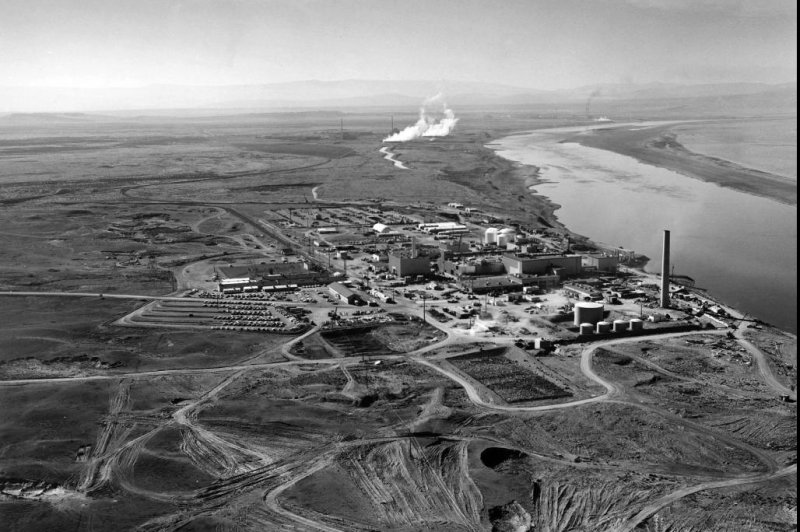The settlement includes nearly $1 million in reimbursed litigation costs. File Photo courtesy of the Department of Energy
Sept. 19 (UPI) -- Workers at Washington's Hanford nuclear plant will get new health protections following decades of reported exposures to radioactive vapors.
The protections were announced in a settlement between the state and the U.S. Department of Energy following a federal lawsuit brought by the Washington attorney general, advocacy group Hanford Challenge and Local 598 of the United Association of Plumbers and Steamfitters, which represents some of the workers at Hanford, three years ago.
The settlement requires testing of new technologies to capture and destroy tank vapors, the installation of vapor monitoring, detection and alarm systems, and $925,000 in reimbursed litigation costs to the plaintiffs.
The settlement was announced Wednesday by Attorney General Bob Ferguson, flanked by advocates and former Hanford workers. Ferguson expressed anguish over how long it took the federal government to address worker safety issues at Hanford.
"There is no way to sugarcoat this, they did not take it seriously," he said.
In addition to the federal government, Washington River Protection Solutions, LLC, a private environmental consultant helping manage cleanup of the site, was named as a defendant.
DOE and WRPS released a joint statement Wednesday saying they were "pleased" with the settlement. They cited previous and ongoing efforts to improve worker safety, such as the implementation of some safety recommendations from independent reviews of the Hanford cleanup conducted by other federal agencies between 2014 and 2018.
"Worker safety is DOE's top priority," the news release said.
Ferguson cited 19 studies over a 20-year period of hazardous conditions at Hanford -- a number of them commissioned by federal agencies -- that documented exposures and a lack of safety measures in place. The Department of Energy instated several safety improvements after the lawsuit was filed, and part of the settlement requires those improvements remain in place.
The case was expected to go to trial in 2019. Ferguson said the lawsuit can continue if the state doesn't believe the federal government is following its obligations under the settlement.
"It's hard for me to think of a case in my entire career that angers me more than this one," Ferguson said. "It is a bureaucracy that did not recognize what happened."
Abe Garza worked at the plant for 33 years around storage tanks -- 177 tanks containing more than 50 million gallons of radioactive waste -- and was exposed to vapors that caused lung and brain damage.
"It's changed my life," Garza said at the news conference. "I just hope it doesn't happen to other workers out there. I think what they've done here is a good thing."
The U.S. Department of Energy estimates 67 tanks have leaked over time. Nearly 9,000 people work at the Hanford site, according to federal government estimates from June.
Over the years, the federal government has paid out $1.5 billion to Hanford workers and their families under the Energy Employees Occupational Illness Compensation Program. In April, the Department of Energy opened a new office in nearby Richland, Wash., to help sick Hanford workers and their families explore options for compensation and medical care.
"It has always been a mystery to me why the Department of Energy continues to engage in constant denial," said Tom Carpenter, executive director of Hanford Challenge, a watchdog group that works with whistleblowers and Hanford workers to draw attention to unsafe conditions.
The 586-square-mile Hanford site was used for the production of nuclear weapons, including production for the plutonium in the two atomic bombs dropped on Japan, for five decades. Production ramped up in the late 1940s and 50s during the Cold War as the United States sought to stockpile nuclear weapons, with the last reactor built in 1959. The site was decommissioned in the late 1980s.
Plutonium production is considered inefficient in that enormous amounts of liquid and solid waste are generated to produce a relatively small amount of plutonium. As a result, workers have spent decades cleaning up millions of tons of solid waste and hundreds of billions of gallons of liquid waste.
"Depending on when the waste was buried, records about what was buried and where it was buried can be either very good, or in some cases, very bad," according to the Department of Energy's official website on the Hanford cleanup. "Just like with the solid wastes, while some records accurately describe the kinds of liquid wastes that were generated and where they went, some of the spills and the volume of the spills went undocumented."
In 1989, the Department of Energy, the Environmental Protection Agency and Washington reached an agreement to clean up the site. The federal government has undertaken efforts to clean up the site but has been hamstrung by a lack of resources and inertia in Congress over new storage cites for the nuclear waste currently held in aging tanks at Hanford near the Columbia River.
Carpenter said Hanford Challenge has documented hundreds of cases of Hanford workers exposed to toxic vapors who reported for medical evaluation.
Ferguson said the settlement achieves every goal of the lawsuit, assuming the federal government follows through.
"This is their last best shot," Ferguson said of the settlement. "We will see how that shakes out."















